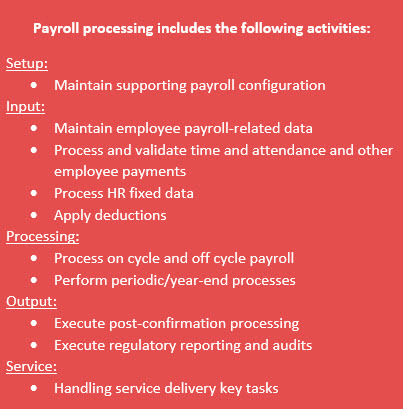
From the employees' perspective, payroll may seem like a relatively simple process (e.g., Did I get paid on time and correctly or not?), but behind the scenes are many complicated moving pieces.
While the payroll process done right comprises many intricacies, its complexity is greatly magnified when you switch payroll providers. The following sections discuss a rationale and methodology for developing a business case for switching payroll providers.
Business case: Definition and rationale
While there are many qualitative or "soft" benefits of switching payroll providers, the hard dollar cost of such an investment can be significant. Generally, a CFO will only be swayed to make such an investment if attempting to articulate the estimated costs and benefits to the extent possible. For example, transformation to a new payroll platform involves:
- Often, a much larger scope and complexity than initially anticipated,
- requirement to review current payroll processes and controls
- potential identification of payroll compliance risks,
- financial investment, and
- a time commitment from existing payroll resources
This is where a business case comes into play. A business case details the explicit, tangible estimated costs and benefits of the investment(s), as well as the qualitative rationale, and justifies the transformation project's commitment to finite resources. Ultimately, the business justifies the change.
Start with strategy
However, your organisation must determine its payroll strategy before working on a business case. Strategy defines the desired future state operating model. ADP's advises clients to think through the decision points within four essential components of a payroll strategy as a prerequisite to business case development:
- Technology requirements and enablement
- Service delivery and governance
- Standardisation and optimisation, and
- Roles, responsibilities and full-time employee specialization.
The business case, in turn, captures the reasoning for implementing the strategy.
Creating a business case
Once your organisation has defined its payroll strategy, it will likely need a business case to justify it to key stakeholders. The business case should include an executive summary, a financial analysis, a risk and efficiency analysis, a deployment strategy and a service delivery strategy.
Executive summary
In the executive summary, your organisation articulates the problem(s) it is trying to solve with a new payroll solution. For example, technology may need to be updated or end of life, integrated with your HR solutions or supported by your business growth strategy. Another issue may be that payroll operations and service delivery must shift from in-house to outsourced or vice versa in an environment where payroll talent is scarce.
Ultimately, your organisation's justification for changing payroll providers is unique to your business. However, many will agree that improving data security, integrity, visibility and measurement, plus better governance, business continuity, efficiency, scalability and delivering a unified user experience, are collectively driving their decision to implement a new payroll solution.
Total cost of ownership
The total cost of ownership (TCO), or cost-benefit analysis, should include both hard and soft costs. Hard costs compare current and future technology and labour costs, while soft costs demonstrate expected savings through cost avoidance and cost reduction. Remember to include one-time implementation fees in the TCO analysis.
When comparing current technology costs, review current contracts for variable fees such as licensing, disaster recovery, maintenance, upgrade, integration, consulting, IT support and any other fees. In addition, the assessment of labour costs should consider all the individuals that perform payroll activities, including HR, finance and shared services.
Additionally, it is essential to consider the soft dollar costs your organisation can expect to save. For example, the estimates (based on market benchmarks plus internal ADP subject matter expertise) that gain from automation and efficiencies can range, on average, from two to three percent of total gross payroll. This includes gains from eliminating outdated configurations, reducing compliance penalties, improving error rates, and general process improvement.
Deployment strategy
Once you have the green light on the project, the next step is to determine the timeline and the approach to implementing your organisation's desired service model. The most desirable approach is to parallel deploy the service model alongside the technology.
Service delivery strategy
From a leading-practice perspective, a payroll governance structure should have a Center of Excellence (COE) led by the senior payroll process owner that oversees policies and standardization, with hubs handling payroll operations, compliance, service center, and escalations (the complexity based on how your payroll team is structured locally and potentially offshore).

Lastly, your organisation will need to evaluate the requirements, skills, and specialization of its people today and how they meet the needs of the future. For example, if the organisation is changing from an in-house to an outsourced model and the technology affords you fewer process requirements, will it impact your current staff and require retraining/upskilling?
Conclusion
Changing your payroll solution requires a transformation effort not for the faint of heart, but it is well worth it for companies looking for a solution that meets their future growth strategy. Senior leaders will be best swayed to payroll transformation by payroll teams that are able to articulate their hard and soft dollar costs.
This story originally published on SPARK, a blog designed for you and your people by ADP®.


